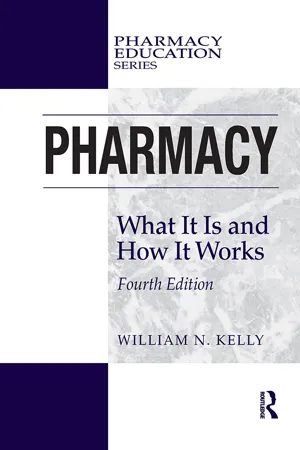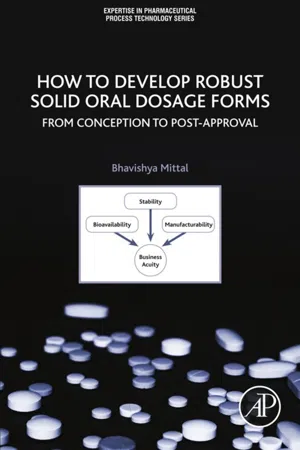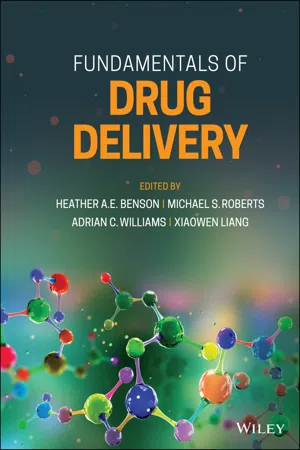Drug development
Drug development is the process of discovering and bringing new pharmaceutical products to the market. It involves identifying potential drug candidates, conducting preclinical and clinical trials to assess safety and efficacy, obtaining regulatory approval, and ultimately commercializing the drug. This multidisciplinary process typically spans many years and requires collaboration between scientists, clinicians, regulatory authorities, and industry partners.
6 Key excerpts on "Drug development"
- eBook - ePub
Pharmacy
What It Is and How It Works
- William N. Kelly(Author)
- 2018(Publication Date)
- Routledge(Publisher)
...Drug discovery and development start with a human need and are based on good science. Good science uses proven scientific methods and avoids shortcuts in designing and developing new drugs. The object of drug discovery is to find new active ingredients or to modify the chemical structures of existing active ingredients of drugs to form the basis of a new drug. The object of Drug development is to provide superior dosage forms and ways of delivering effective drugs into the body. The discovery of a new drug (the active ingredient of a drug product) and development of one or more dosage forms are so complex and technical that no one individual is qualified to carry out the operation from beginning to end. Thus, drug discovery, development, and approval take the services of many trained workers skilled in applying their knowledge to the problems of pharmacy. 5 Pharmaceutical development is mostly done by scientists—usually those with a doctoral (PhD) degree—working for pharmaceutical companies in which extensive research laboratories, sophisticated equipment, and resources are available to do the research. However, pharmaceutical research is also conducted in most of the 140 colleges of pharmacy. Most bench (laboratory) research on drugs is performed by basic science faculty members. Pharmaceutical companies often contract with a college of pharmacy or an independent research institute to conduct some of their drug research. DRUG DISCOVERY The active ingredients of drugs are extracted from plants, mammalian hormones, microorganisms, and various semisynthetic and synthetic compounds. Today, some of the synthetic compounds are genetically engineered. P LANT P OISONS Before it was discovered that drugs could be synthesized, plants were the main source of physiologically active substances that could be tested for therapeutic properties...
- eBook - ePub
Pharmaceutical Dosage Forms and Drug Delivery
Revised and Expanded
- Ram I. Mahato, Ajit S. Narang(Authors)
- 2017(Publication Date)
- CRC Press(Publisher)
...Chapter 2 Drug development LEARNING OBJECTIVES On completion of this chapter, the students should be able to Describe the Drug development and regulatory process. Discuss the role of the Food and Drug Administration (FDA) in the approval of a dosage form. Differentiate between an investigational new drug (IND) application, a new drug application (NDA), and a biologics license application (BLA). Identify the three key components of pharmaceutical development. Identify the objectives and key deliverables of the three stages of clinical trials. Describe a drug’s life cycle and how it is driven by intellectual property rights. 2.1 INTRODUCTION The process of discovery and development of safe and effective new medicines is long, difficult, and expensive. A new molecular entity (NME), sometimes also called a new chemical entity (NCE), is characterized for its potential therapeutic applications and toxicological profile in nonprimate species, which is followed by extensive animal and human testing. On average, it costs a company more than $1 billion and 10–15 years to get one drug from the laboratory to patients. Only five in ~5000 compounds that enter preclinical testing make it to human testing. Only one of those five drugs entering human clinical trials is approved for commercialization. New drugs include prescription drugs, over-the-counter (OTC) medications, generic drugs, biotechnology products, veterinary products, and/or medical devices. Over-the-counter drugs do not require a physician’s prescription. Drug development also focuses on new dosage forms, routes of administration, and delivery devices for existing drugs. A typical drug discovery process entails target identification, such as a protein or an enzyme whose inhibition may help in a disease state. The structural features necessary in a potential drug candidate are identified using in silico molecular modeling...
- eBook - ePub
Drug Discovery and Development - E-Book
Technology in Transition
- Raymond G Hill(Author)
- 2012(Publication Date)
- Churchill Livingstone(Publisher)
...The nodes indicated by circles represent the start and finish points of each activity, and the diagram indicates which activities need to be completed before the next can begin. By assigning timescales to each activity, the planned overall development time can be determined and critical path activities identified. (A) Preclinical development. (B) Clinical development. In this section of the book we outline the main technical and experimental parts of the work that goes into Drug development, namely toxicology, pharmaceutical development and clinical studies. Chapter 19 discusses the principles underlying the patenting of drugs. Chapter 20 describes how regulatory bodies go about evaluating new compounds for registration, and Chapter 21 presents an introduction to the principles of pharmaceutical marketing. Chemical development, covering the specialized technical aspects of producing the drug substance economically and safely on a large scale, as well as the control measures needed to ensure consistent high quality of the final product, is beyond the scope of this book (see Gadamasetti, 2007 ; Repic, 1998 for a full account of this subject). The interface between discovery and development For the purposes of this book, Drug development is presented as an operation separate from discovery and following on from it, but the distinction is actually not clear-cut. Increasingly, as has been stressed in Chapters 9 and 10, activities previously undertaken during development are taking place earlier, as an integral part of the discovery process. The emphasis on the ‘druggability’ of leads (Chapter 9) reflects a concern for focusing on structures that are least likely to have unsatisfactory pharmacokinetic, toxicological or stability problems...
- eBook - ePub
How to Develop Robust Solid Oral Dosage Forms
From Conception to Post-Approval
- Bhavishya Mittal(Author)
- 2016(Publication Date)
- Academic Press(Publisher)
...However, in reality the pharmaceutical industry is a highly dynamic industry. After all, Drug development is a complex team sport, and, most of the time, a decision on any aspect of product development cannot be made in isolation without understanding its impact on the other discipline's work. From this perspective, one cannot help but appreciate the various sciences working together to achieve a common goal: the development of a safe and effective drug product that will be provided to a patient suffering from a particular disease. Although it is difficult to claim any one particular discipline's contribution superior to another when it comes to Drug development, the most identifiable result of pharmaceutical research is the physical drug product itself. Despite everything, the drug product is eventually the medium through which the drug is delivered to a patient. Hence, it is essential for formulation scientists to realize their responsibility, the importance of their contribution to Drug development, and be an enthusiastic and active partner in the entire process. It is equally important for formulation scientists to acknowledge and appreciate the role that other disciplines play and be aware of the various sciences that make it possible to develop a safe and effective dosage form. 1.2. The Big Picture What is the big picture in drug product development? Imagine for a minute that we are not in the business of pharmaceutical Drug development but in the business of manufacturing furniture. Also imagine, that the current project that we have requires us is to manufacture a three-legged stool with a nice and comfortable seat. Our ultimate aim is to develop a product that is useful, acceptable, and appealing to a paying customer...
- eBook - ePub
- Heather A. E. Benson, Michael S. Roberts, Adrian C. Williams, Xiaowen Liang, Heather A. E. Benson, Michael S. Roberts, Adrian C. Williams, Xiaowen Liang(Authors)
- 2021(Publication Date)
- Wiley(Publisher)
...4 The Pharmaceutical Drug development Process: Selecting a Suitable Drug Candidate Lionel Trottet DMPK (Drug Metabolism and PharmacoKinetics), Galapagos, Romainville, France In the pharmaceutical industry, getting to th e stage of drug candidate selection is a relatively early part of the full process of discovering a new medicine. It is generally reached after 3–4 years, while the full process leading up to new product launch will last about 10–12 years and can be divided in five stages [1], as shown in Figure 4.1. During the first part, the target is studied to assess the value of its mechanism of action compared to existing targets for a given indication. If there is reasonably strong confidence that such a target is of added value, the project will move to a drug discovery stage (hit and lead optimization), where many molecules will be synthesized and tested in order to find the drug candidate. After that, the selected molecule will progress into a preclinical development stage where various efforts especially in safety assessment, pharmaceutics development and chemical development will occur. Then the clinical phases will start and eventually, if successful, a New Drug Application (NDA) will be filed to regulatory bodies. Once approved, the new medicine will be launched. Reaching the candidate selection milestone is a critical step that maybe underestimated when looking at the full drug discovery process, where one may tend to focus on the late clinical phases results and not to the decisions made earlier in the process. This is, however, the critical one as once the choice of the candidate molecule has been made, its quality will not improve in later phases. Indeed, the role of such late phases is only to demonstrate the clinical benefits vs. its risks of the selected molecule to obtain regulatory approval...
- eBook - ePub
Medical Product Regulatory Affairs
Pharmaceuticals, Diagnostics, Medical Devices
- John J. Tobin, Gary Walsh(Authors)
- 2011(Publication Date)
- Wiley-Blackwell(Publisher)
...The use of stem cells to create replacement tissues and organs is seen as a route for future advance. However, a number of ethical questions have been posed regarding the use of stem cells of embryonic origin, and these difficulties must be resolved before the practical benefits of this line of research can be realised. An overview of the drug discovery and development process is shown in Figure 3.2. Figure 3.2 Modern drug discovery and development processes. 3.4 Drug development Once potential drug compounds have been identified, a long and arduous process of Drug development and evaluation ensues. Before embarking on the wide variety of activities and studies that are required, it is normal practice to examine structurally related compounds, particularly in the case of small-molecule drugs. There are a number of reasons for this. First, it is possible that an analogous compound could actually be more potent than the candidate compound initially identified. Second, by examining a broad range of compounds, it reduces the chances of a competitor being able to bring similar drugs to market. At this early stage, once initial compounds have been characterised and shown to have potential therapeutic value, it is advisable to prepare a patent application. Patents grant legal protection to applicants to exclusively commercialise their “invention” in exchange for making a detailed description of the “invention” available to the public. To obtain a patent, the subject of the invention must be novel, have utility, and should advance the “state of the art” beyond that which previously existed. The standard term of protection that is granted is 20 years from the date a patent application is filed. Drug developers may apply for an extension of the protection period to take account of time lost while conducting clinical trials and obtaining marketing authorisations...





